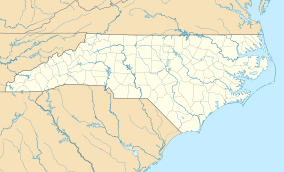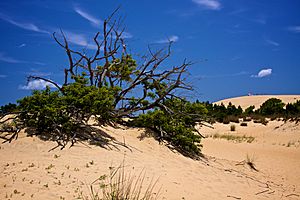Jockey's Ridge State Park facts for kids
Quick facts for kids Jockey's Ridge State Park |
|
|---|---|
|
IUCN Category III (Natural Monument)
|
|

A sand dune at Jockey's Ridge State Park
|
|
| Location | Dare, North Carolina, United States |
| Area | 427 acres (173 ha) |
| Elevation | 100 ft (30 m) |
| Established | 1975 |
| Named for | Jockey's Ridge |
| Governing body | North Carolina Division of Parks and Recreation |
| Website | Jockey's Ridge State Park |
| Designated: | 1974 |
Jockey's Ridge State Park is a special place in Dare County, North Carolina. It's home to the tallest active sand dune system in the eastern United States. This amazing park covers about 427 acres and is located in Nags Head, North Carolina. It's the most visited park in North Carolina's park system!
Jockey's Ridge is a day-use park, which means you can visit during the day but there are no campgrounds for overnight stays. The park has three unique natural areas: the Roanoke Sound, the giant sand dunes, and a maritime forest. Sometimes, after it rains, temporary ponds called vernal pools form at the bottom of the dunes. While few animals live directly on the dunes, you might see some tough plants, like tall grass, growing near the bottom.
The park is open all year, except for Christmas Day. There are no fees to enter, park, or join programs. You can find the park entrance at Milepost 12 on S. Croatan Highway/US 158. Park rangers lead fun programs throughout the year. You can also explore nature trails, access the sound, and use picnic areas. Many visitors love watching the sunset over the sound, looking for birds, and flying kites. The park also has outdoor bathrooms, usually open from spring's last frost to fall's first frost.
During the summer, when it's busiest, it's super important to bring your own water. There is no fresh water available inside the park. The dune area can feel like a desert, with temperatures reaching 110 degrees Fahrenheit. The sand itself can be even hotter, up to 30 degrees warmer!
The park's visitor center has a museum where you can learn about the park's history and nature. It teaches you about sand dunes, local plants and animals, weather, and even pirates! A hang-gliding school also offers lessons right in the park. You can reach the main dune area from the visitor center's back deck or the parking lot by walking along a 350-foot boardwalk. Sandboarding is another exciting activity you can try on the dunes.
Contents
Park History and How It Formed
Scientists believe the Outer Banks barrier islands were left over from the last ice age, which ended about 12,000 years ago. Jockey's Ridge itself started forming around 7,000 years ago. It's thought that minerals like quartz washed from the mountains to the ocean, creating sand. Storms and hurricanes then pushed this sand onto the beaches. Winds then blew the sand, a process called saltation, causing it to pile up and form the huge dune system we see today.
Long ago, the dunes of the Outer Banks stretched all the way into southern Virginia. Sailors in the 16th century used Jockey's Ridge as an important landmark to help them navigate the coast.
By the early 1900s, the Outer Banks became a popular spot for tourists. This led to a lot of building and development. Many local people wanted to protect the beautiful dune area. In the summer of 1973, bulldozers started clearing land on the sound side of Jockey's Ridge. Carolista Baum, a local resident, found out from her children who were playing nearby. She bravely stopped the bulldozer operator and demanded he shut down his machine. Soon, people started petitions to "Save Our Sand Dune," and a group called "People to Preserve Jockey's Ridge" was formed.
Because of these efforts, on July 25, 1974, Jockey's Ridge was named a National Natural Landmark. With money from North Carolina and the U.S. government, about 152 acres were bought in 1975 to create Jockey's Ridge State Park.
How Jockey's Ridge Got Its Name
There are a few ideas about how Jockey's Ridge got its name. An old document from 1753 mentioned "Jockey's Hill." A 1953 map called the area "Jackey's Ridge," suggesting a family named Jackey or Jacock might have owned the land. A popular story says the name comes from local "Bankers" who used to catch and race Spanish Mustangs. These horses came from explorer ships that wrecked offshore. Riders, or jockeys, raced their horses on the flat areas at the bottom of the big dune. The steep sides of the ridge were like a natural grandstand for people to watch the races.
Protecting the Shoreline
In 2008, Jockey's Ridge State Park worked with other groups to build a natural oyster bulkhead along the park's northwestern edge. This project had two main goals: to protect and stabilize the shoreline along the sound, and to help new oysters grow in the water. The project used almost 4,000 bushels of recycled oyster shells.
Wind Power at the Park
In 2010, Jockey's Ridge became the first state park in North Carolina to use wind power. A 10-kilowatt wind turbine helps power the park, producing about 700-900 kilowatt-hours of electricity each month. This helps reduce the park's energy use. Money for this project came from the North Carolina Parks and Recreation Trust Fund.
Park Ecosystems
Jockey's Ridge State Park is home to three main ecosystems, each with its own unique features.
The Shifting Sand Dunes
The tall dune area of Jockey's Ridge is called a medano. This means it's a huge, uneven, shifting hill of sand with very few plants. The desert-like conditions on the dunes make it hard for most plants and animals to live here. The famous winds of the Outer Banks constantly move the sand. Stronger winter winds from the northeast cause the dunes to shift about one to six feet to the southwest each year. However, the surrounding maritime forests help keep the dune somewhat stable. Scientists estimate there are about 30 million tons of sand in the park!
The Maritime Forest Ecosystem
The maritime forest is where most of the park's plants and animals live. These forests help stabilize the sand dunes. In return, the dunes protect the forests from strong winds and harsh salt spray from the ocean.
Forest Flora: Plants of the Park
Many plant species have adapted to living on the Outer Banks. Live oaks are very tough trees common in the southeastern U.S. You can find thick bushes of southern wax myrtle, eastern redcedar, live oak, and redbay (Persea borbonia) in sheltered spots near the dunes and picnic areas. West of the dunes, there's a forest with live and southern red oaks, hickory trees, American sweetgum, and loblolly pine. Smaller trees like dogwood and sassafras grow beneath them.
Forest Fauna: Animals of the Park
Many animals living in Jockey's Ridge have found ways to survive in this environment. Most of them are active at night to avoid the hot summer temperatures, so visitors often don't see them. However, these animals leave clear clues behind: their tracks! Some interesting creatures that live in the park include the gray fox, six-lined racerunner lizard, Virginia opossum, tiger beetle, eastern spadefoot toad, and the antlion.
The Roanoke Sound Ecosystem
The Roanoke Sound is a shallow, brackish (a mix of fresh and saltwater) body of water. It separates Bodie Island from Roanoke Island. The sound stays shallow because the same winds that create the dunes also blow sand from the dunes into the water. The calm waters of the sound act as a hatchery for many types of both freshwater and saltwater fish. You might find croakers, shrimp, striped burrfish, pipefish, blue crabs, and seahorses near the park. Many kinds of shorebirds also live along the sound. Ospreys are a fascinating sight during the warmer months in this area.





